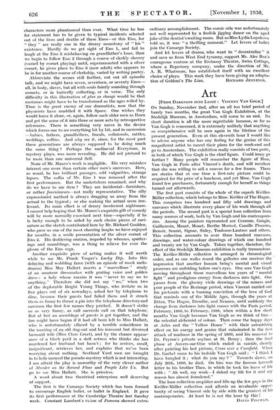Art
[FROM DARKNESS INTO LIGHT VINCENT VAN Goon.] ON Sunday, November 2nd, after an all too brief period of barely two months, the great Van Gogh Exhibition, at the Stedelijk Museum, in Amsterdam, will come to an end. Its short duration is all the more regrettable because, so far as Van Gogh is concerned, it is extremely unlikely that anything so comprehensive will be seen again in the lifetime of the present generation. Even at this eleventh hour I would like to advise anyone who has any feeling for the genius of this magnificent artist to cancel their plans for the week-end and go to Amsterdam. The exhibition really consists of two parts, in both of which Van Gogh is the chief figure. Could irony go further ? Many people will remember the figure of Mme. Van Gogh in Paris after Vincent's death, and will recollect that she was willing to sell a canvas for a few francs. There are stories that at one time a first-rate picture could be acquired for the price of a luncheon, and yet Mme. Van Gogh found few purchasers, fortunately enough for herself as things turned out afterwards.
The first part consists of the whole of the superb Kroller- Muller collection, which belongs to Mme. Kroller of The Hague. This comprises two hundred and fifty odd drawings and canvases which illustrate every phase of his work through all the periods. The second part is a special loan collection front many sources of work, both by Van Gogh and his contempora- ries. Among the painters represented are Cezanne, Gaugin, Guillaumin, Manet, Monet, Berthe Morisot, Camille Pissarro, Renoir, Seurat, Signac, Sisley, Toulouse-Lautrec and others. This collection amounts to over three hundred canvases, drawings, and water-colour drawings of which one hundred and twenty are by Van Gogh. Taken together, therefore, the effect of the Stcdelijk Museum exhibition is really tremendous. The Krtiller-Milller collection is arranged in chronological order, and as one walks round the galleries one receives the impression that another human being's mental and visual processes are unfolding before one's eyes. One sees Van Gogh moving throughout those marvellous ten years of " mental fight " and prodigious energy from darkness into light. One passes from the gloomy virile drawings of the miners and poor people of the Borinage period, when Vincent carried out his pastorate with a burning conviction of the love of God that reminds one of the Middle Ages, through the years at Etten, The Hague, Drenthe, and Neunen, until suddenly the change from darkness into light comes with the Paris period, February, 1880, to February, 1888, when within a few short months Van Gogh becomes Van Gogh as we think of him— the celestial alchemist of colour. Then come the happy days at Arles and the " Yellow House " with their astonishing effect on his energy and genius that culminated in the first attack of madness in the spring of 1899, and his removal to Dr. Peyron's private asylum at St. Remy ; then the final phase at Auvers-sur-Oise which ended in suicide, shortly after painting his last picture, Cross over a Cornfield. When Dr. Cachet came to his bedside Van Gogh said : " I think I have bungled it ; what do you say ? " Towards dawn, on July 20th, 1890, he died. On hint was the famous farewell letter to his brother Theo, in which he took his leave of life with " Ah well, my work—I risked my life for it and my reason has almost foundered."
The loan collection amplifies and fills up the few gaps in the Kroller-Muller collection and affords an invaluable oppor- tunity of seeing Vincent side by side with the greatest of his contemporaries. At least he is not the loser by this I
DAVID .FINCIIA5T.










































 Previous page
Previous page